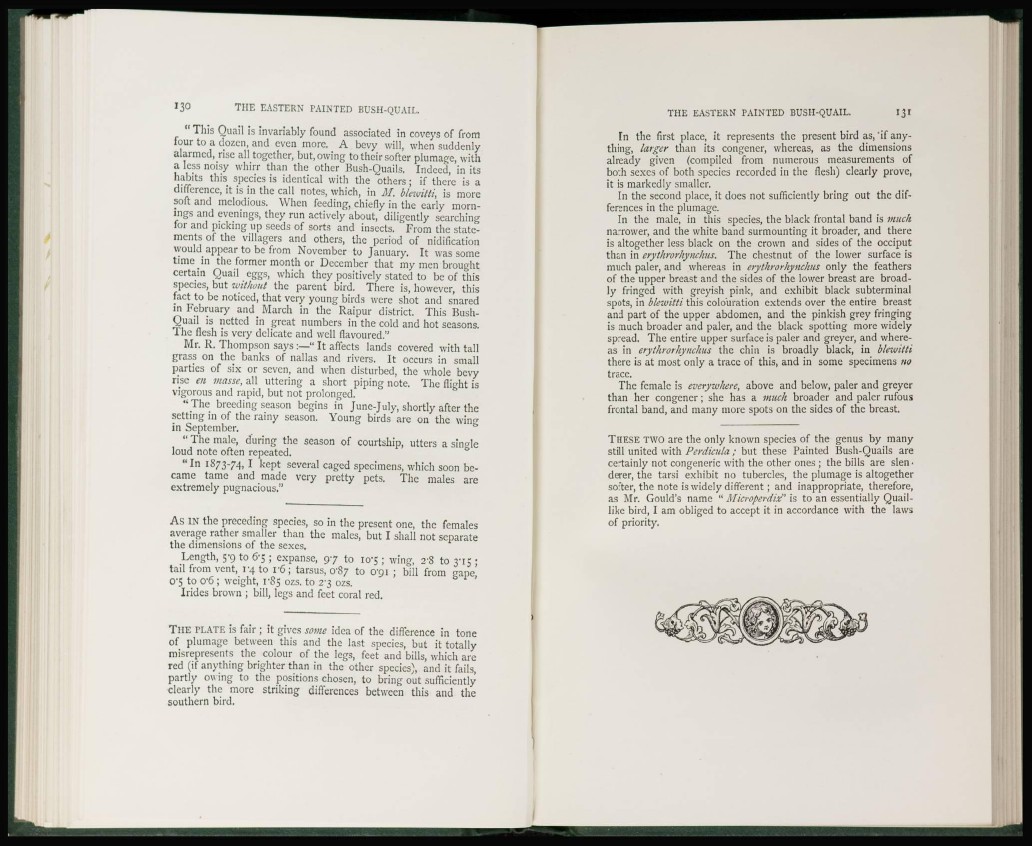
130 THE EASTERN PAINTED BUSH-QUAIL.
" This Quail is invariably found associated in coveys of from
four to a dozen, and even more. A bevy will, when suddenly
alarmed, rise all together, but, owing to their softer plumage, with
a less noisy whirr than the other Bush-Quails. Indeed, in its
habits this species is identical with the others ; if there is a
difference, it is in the call notes, which, in M. blewitti, is more
soft and melodious. When feeding, chiefly in the early mornings
and evenings, they run actively about, diligently searching
for and picking up seeds of sorts and insects. From the statements
of the villagers and others, the period of nidification
would appear to be from November to January. It was some
time in the former month or December that my men brought
certain Quail eggs, which they positively stated to be of this
species, but without the parent bird. There is, however, this
fact to be noticed, that very young birds were shot and snared
in February and March in the Raipur district. This Bush-
Quail is netted in great numbers in the cold and hot seasons.
The flesh is very delicate and well flavoured."
Mr. R. Thompson says :—" It affects lands covered with tall
grass on the banks of nallas and rivers. It occurs in small
parties of six or seven, and when disturbed, the whole bevy
rise cn masse, all uttering a short piping note. The flight is
vigorous and rapid, but not prolonged.
"The breeding season begins in June-July, shortly after the
setting in of the rainy season. Young birds are on the wing
in September.
" The male, during the season of courtship, utters a single
loud note often repeated.
" I n 1873-74, I kept several caged specimens, which soon became
tame and made very pretty pets. The males are
extremely pugnacious."
As IN the preceding species, so in the present one, the females
average rather smaller than the males, but I shall not separate
the dimensions of the sexes.
Length, 5-9 to 6'S ; expanse, 9 7 to io'5 ; wing, 2'8 to 3-15 •
tail from vent, 1 4 to r6; tarsus, 0-87 to 0-91 ; bill from "ape'
0'5 to o-6 ; weight, ['85 ozs. to 2-3 ozs. & '
Irides brown ; bill, legs and feet coral red.
THE PLATE is fair ; it gives some idea of the difference in tone
of plumage between this and the last species, but it totally
misrepresents the colour of the legs, feet and bills, which are
red (if anything brighter than in the other species), and it fails,
partly or. ing to the positions chosen, to bring out sufficiently
clearly the more striking differences between this and the
southern bird.
THE EASTERN PAINTED BUSH-QUAIL. ' 3 '
In the first place, it represents the present bird as,'if anything,
larger than its congener, whereas, as the dimensions
already given (compiled from numerous measurements of
both sexes of both species recorded in the flesh) clearly prove,
it is markedly smaller.
In the second place, it does not sufficiently bring out the differences
in the plumage.
In the male, in this species, the black frontal band is much
narrower, and the white band surmounting it broader, and there
is altogether less black on the crown and sides of the occiput
than in erythrorhynchus. The chestnut of the lower surface is
much paler, and whereas in erythrorhynchus only the feathers
of the upper breast and the sides of the lower breast are broadly
fringed with greyish pink, and exhibit black subterminal
spots, in blewitti this colouration extends over the entire breast
and part of the upper abdomen, and the pinkish grey fringing
is much broader and paler, and the black spotting more widely
spread. The entire upper surface is paler and greyer, and whereas
in erythrorhynchus the chin is broadly black, in blewitti
there is at most only a trace of this, and in some specimens no
trace.
The female is everywhere, above and below, paler and greyer
than her congener ; she has a much broader and paler rufous
frontal band, and many more spots on the sides of the breast.
THESE TWO are the only known species of the genus by many
still united with Perdicula ; but these Painted Bush-Quails are
certainly not congeneric with the other ones ; the bills are slenderer,
the tarsi exhibit no tubercles, the plumage is altogether
softer, the note is widely different; and inappropriate, therefore,
as Mr. Gould's name " Microperdix" is to an essentially Quaillike
bird, I am obliged to accept it in accordance with the laws
of priority.